South Phoenix culture and community to be celebrated in new light rail art
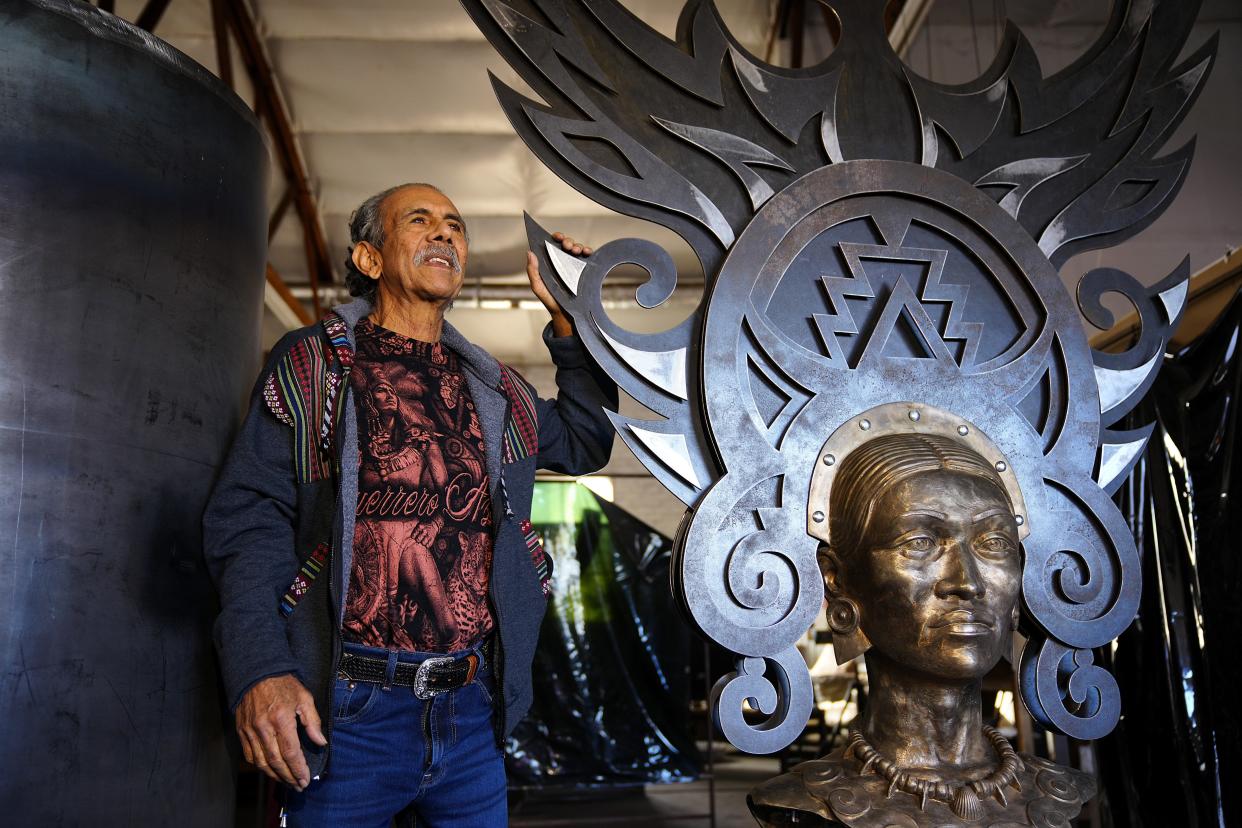
When the light rail extension to south Phoenix is completed in 2024, passengers traveling down South Central Avenue will find sculptures, murals and other public art along the 5.5-mile route from downtown Phoenix to Baseline Road.
The art along the extension will add to the dozens of visual projects that already adorn the light rail's routes in Phoenix, Mesa and Tempe. But the new pieces will have a special focus on south Phoenix, celebrating the communities and individuals integral to its history.
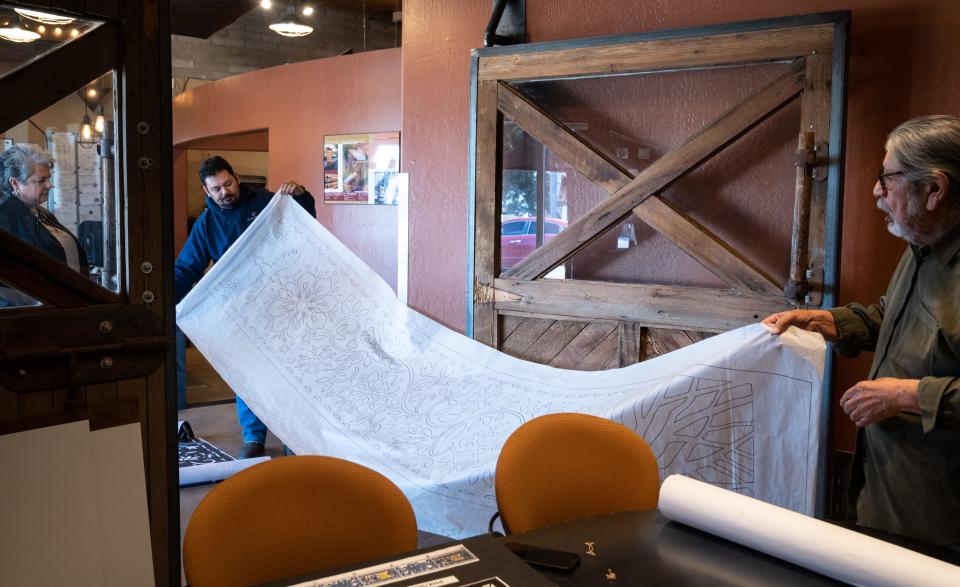
Valley Metro’s art budget is 1% of the overall construction budget for the South Central Extension and Downtown Hub project. Artists commissioned for stations received $260,000, while artists commissioned for the traction power substation and signal buildings received $44,000. Emerging artists were recruited for the substation and signal buildings, said M.B. Finnerty, Valley Metro’s public art administrator.
The artists were chosen in 2017 by selection committees of community members. Here’s an early look at some of the projects that are underway.
At Carter Road, a mural to honor pillars of south Phoenix
Therosia Reynolds will celebrate her childhood in south Phoenix in her mural at the Carter Street Traction Power Substation.
The mural will include five portraits flanked by two scenes “honoring our past and our future.” The murals will appear against a backdrop of the flower farms that used to line Baseline Road, as well as South Mountain, including the “red light spires" that serve as a sign of home for many, Reynolds said.
“One will be a faceless Indigenous person from the Tohono O'odham people who were the originators and the foundation builders for south Phoenix,” she said. “And then at the end, there'll be a little girl. And I haven't yet decided what to paint her as, but representing our future. And she'll be planting a new tree.”
Reynolds’ background as an artist began during her childhood in south Phoenix. Because of a debilitating neurological condition she developed at 14, she said, she was unable to take any electives besides art.
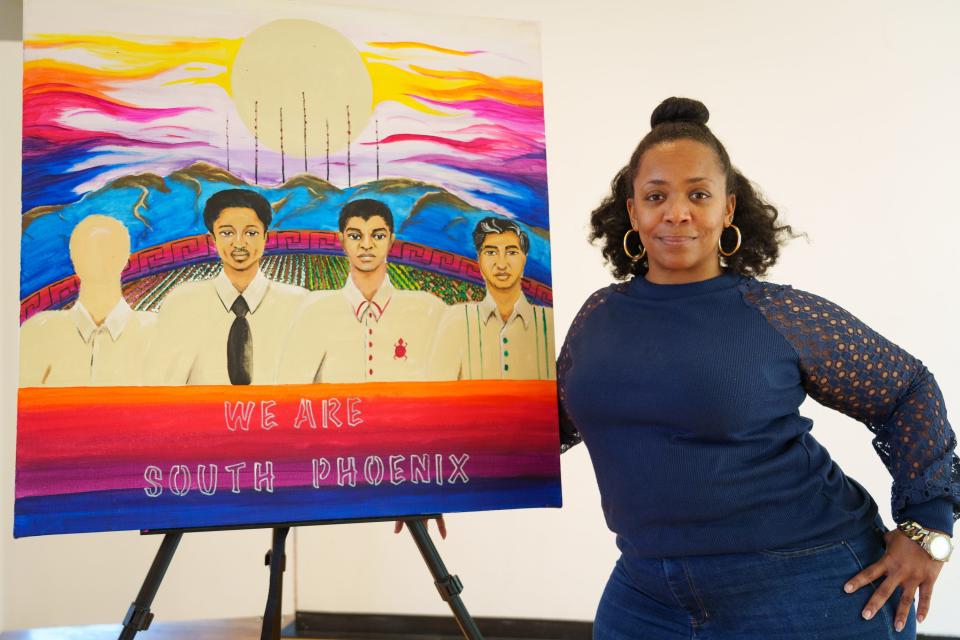
“I had this amazing art teacher who himself was paralyzed from the waist down,” she said. “So he understood the struggles of what my body was going through, because there would be days when I was paralyzed. There would be days when my hands wouldn't work. And he would have me do origami, like 100 cranes. Calligraphy.”
Reynolds’ art teacher was one of many people who supported her through her health condition, which lasted until she was 18, she said. She took art and theater classes at the South Phoenix Youth Center, where she found mentors who "invested in me as an artist," she said. Throughout her childhood, she was surrounded by individuals who cared for her community.
“I grew up in the hood of south Phoenix, which was predominantly Black because of redlining and racism," she said. "But there was so much investment in that Black community,” she said.
The mural she will create for the light rail extension will honor some of the individuals who she saw as pillars in the community.
“We don't go far without honoring our past heroes and our present ones,” she said.
She remembers Calvin C. Goode, a Phoenix civil rights leader and the second Black Phoenix council member, called the “conscience” of Phoenix City Council, regularly visiting her class at Palmdale Elementary School to read to students and encourage them. “He made himself look like love to us,” she said. Decades later, just months before he died, she recalls seeing him at a Black Lives Matter protest. “This man was in his nineties. And he's still fighting the good fight,” she said.
"He reminded us that our voice mattered," Reynolds said, and in the mural, he will be "pointing the way."
There will be a portrait of Hiroshi “Nick” Nakagawa. She fondly remembers him chasing her out of his flower grove on Baseline Road: “‘Kids, what are you doing over here?’ ‘Smelling tulips.’”
“Those Japanese flower gardens were the product of Japanese internment camp victims who took that tragedy and produced treasure for the whole of south Phoenix,” she said.
The mural will feature a portrait of Elizabeth White, the founder of Mrs. White’s Golden Rule Cafe, which has been open since 1964, and the grandmother of the founder of Lo-Lo’s Chicken & Waffles. “Her family has developed into ... something beautiful,” Reynolds said.
Reynolds remembers visiting White's soul food restaurant in her 20s. It was cash only, and she had forgotten her debit card. But Mrs. White didn’t let her go hungry, she said. “‘We feeding you,’" Reynolds recalled White saying. “And she makes sure I have everything I want and need.”
In the mural, “Mrs. White will be holding a plate that we all know her for, serving our community,” Reynolds said. Two more portraits will depict labor leader Cesar Chavez and Ira Hayes, a member of the Gila River Indian Community who was one of the six Marines photographed raising the U.S. flag at Iwo Jima.
A reporter once called Reynolds’ work “color aggressive,” she said.
“It’s a title I wear proudly,” she said. Her art for the light rail extension will be no exception.
“That's because I come from graffiti and groves and flower gardens,” she said. “I come from the souped-up cars. My uncles used to have a car club, where you put the cars on four-wheel motion, and you do the pin striping and candy paint and chameleon paint.”
The portraits will be accompanied by her love poem to south Phoenix, titled "We Are South Phoenix," she said.
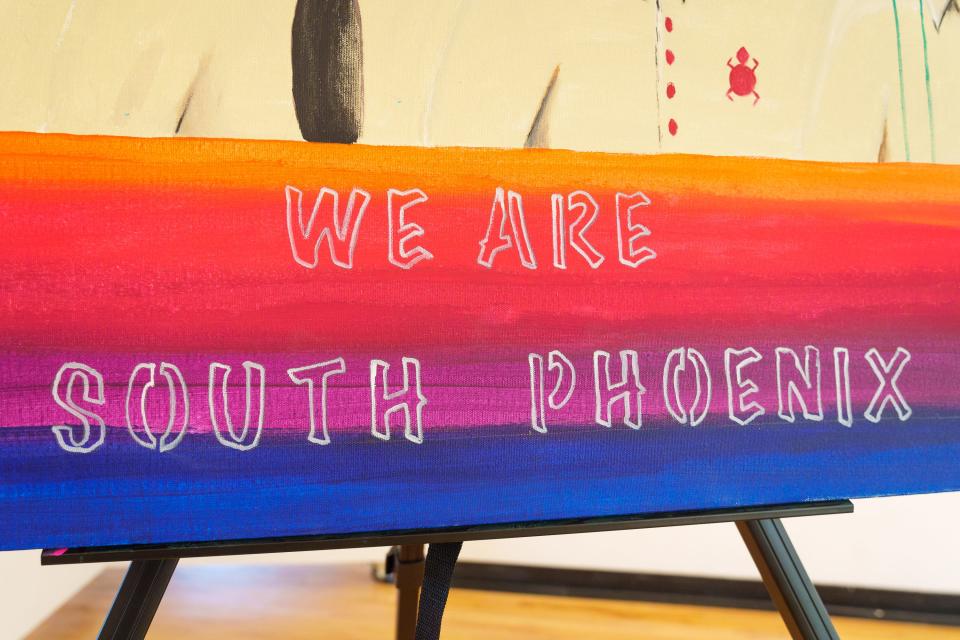
"In the poem, I say we are children of mountain and soil," she said. "I grew up with people who put their hands and their feet to the soil in the shadow of that mountain. South Mountain is considered sacred to the Indigenous people. But it has also stood as a symbol of protection and home for the rest of us."
In her poem, she said, she will honor the culture she grew up around and will call on south Phoenix to "remember who we are."
"The marches for Arizona to have MLK Day. I remember how important that was, leaving from Eastlake Park every year ‘til we got the MLK holiday here. That march was filled with dancers. It was literally a parade," she said. "There was something magical about the energy of it."
Reynolds moved to Mesa to become part of an artist community, to "follow the dream that they all set me on that path for" and to "export what I learned in south Phoenix: Serve your community. Encourage your people. Love on people."
As for the future of south Phoenix, she welcomes new residents and visitors that the light rail extension may bring.
But she wants people, she said, to come “sit at the table that Nana has put out, that Big Mama has put out, that the Tohono O'odham people have put out, that the Japanese have put out, and don't try to change the table to what you want it to be for your comfort, but instead say, how can I learn? Can I be a part of this?”
“You don't come in and be family by tearing down what was already there,” Reynolds said. “You come in and be family by saying, ‘What can I add? Do I need to add anything? And if you don't want me to add anything, can I just sit in the room and just be comfortable and enjoy y'all?'”
Community handiwork coming to Roeser Road's station
At the South Central Avenue and Roeser Road station, light rail passengers will find art that pays tribute to south Phoenix in the form of six, 12-foot-tall steel panels and nearly 200 tiles painted by community members.
The steel panels, which will be placed behind the seating area and on the railings, will focus on elements of south Phoenix history and culture. The ideas for the panel designs were drawn from conversations held with community members. The two artists commissioned for the station, Emily Costello and Martin Moreno, have both lived in south Phoenix for decades.
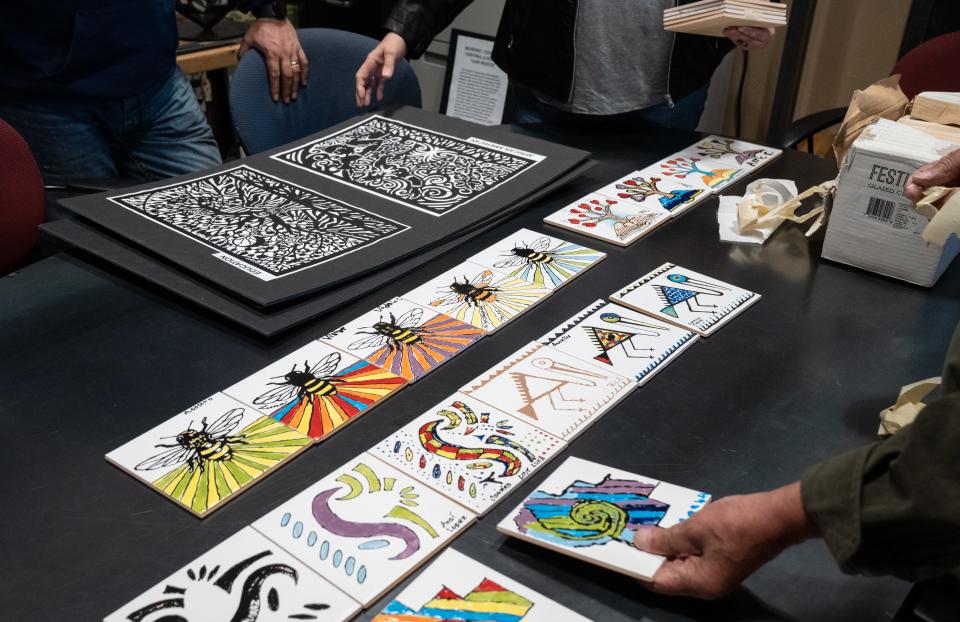
One panel will include stylized designs inspired by water vessels found within ancient Tohono O’odham sites. Another will focus on the Latino community, with elements that highlight the legacy of Cesar Chavez and the Virgin of Guadalupe, “not necessarily as a religious icon,” Costello said, but for “the way she champions ... the underdog.” A panel to celebrate the African American community will include imagery of a jazz singer and a symbol from the Kingdom of Benin, Moreno said.
An education-themed panel will depict “trees of knowledge and books opening and blooming into plants,” Moreno said. A panel to honor the land will feature elements of cotton, corn and an abstracted version of South Mountain. Illuminated columns, with cutouts of hummingbirds and flowers, will pay tribute to south Phoenix flower farms.
Above the panels, the station will feature hand-painted tiles — the handiwork of nearby residents. Costello and Moreno wanted to ensure their installation is "not just plop artwork where it's an artist's rendition of the community, but it's a way to incorporate their concerns and their history and their culture into the designs,” Moreno said.
Community members attended workshops at The Sagrado Galleria in south Phoenix to paint and sign tiles. Community members chose a tile embellished with a pre-designed symbol that resonated with them and added their own spin to it. “We wanted the community to have ownership,” Costello said. “We wanted the community to have pride in what was going up and feel like it was their art, not just our art.”
“South Phoenix is a colorful community,” Moreno said. “I would like to see an expansion of that, where art is everywhere and adorns every corner of the south Phoenix area.”
A 20-foot-tall 'mother of all waters' at Baseline Road
For what will be his largest public art commission to date, and “surely the most important,” Mesa-based sculptor and mask maker Zarco Guerrero will create a 20-foot-tall sculpture that he calls the “mother of all waters.” The piece will be installed at the light rail extension's Baseline Road station.
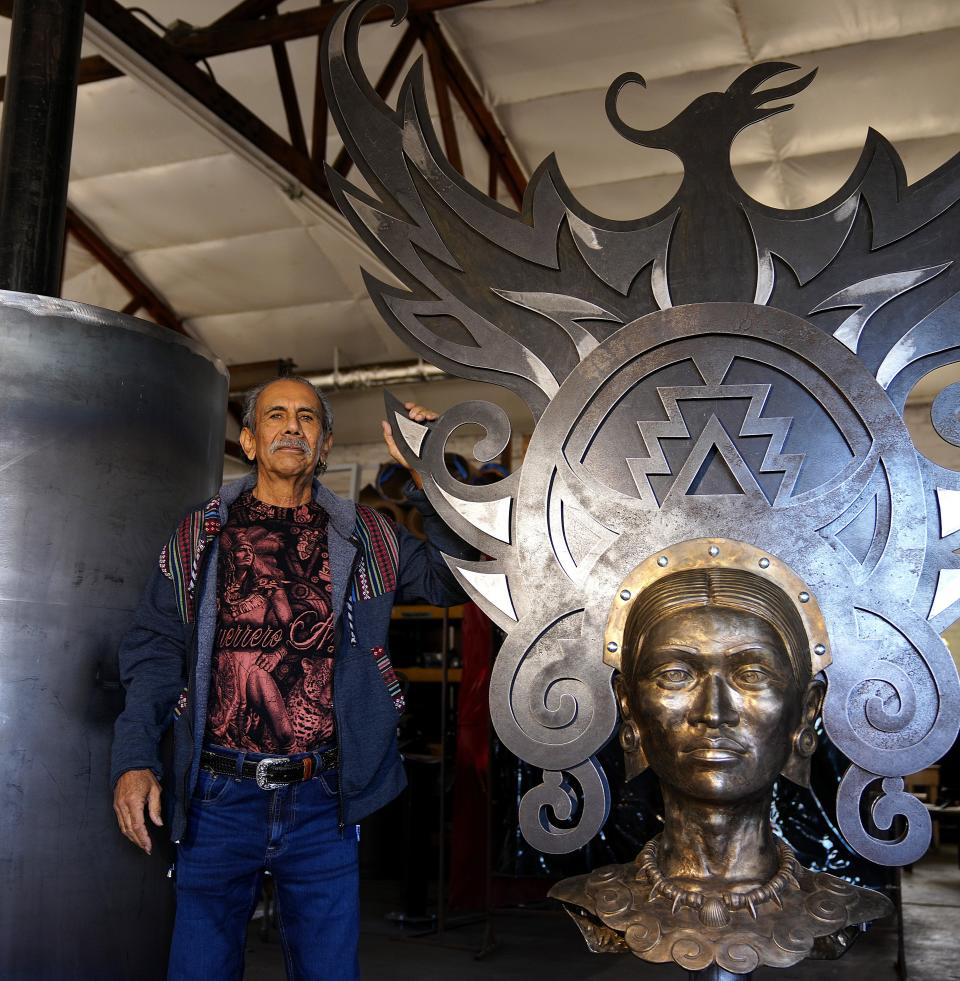
The towering female figure will "pay homage to the legacy of water" in the Valley, he said, and especially to the Gila and Salt rivers. Her steel cutout dress will mimic flowing water, and she will wear a headdress, which includes stylized symbols that represent water in some form — clouds, rainfall — and a phoenix bird rising out of the top.
The symbols on the figure's headdress will reflect Guerrero's blending of southwestern and Mexican Indigenous symbols "to come up with something more universal," he said.
In front of the figure will be a sculpture of plants, including corn.
“This was a super prolific place to create abundant amounts of corn, beans and squash,” Guerrero said.
He hopes the sculpture will direct people to educate themselves about the “glorious past that we have here,” he said.
Madeleine Parrish covers south Phoenix for The Arizona Republic. Reach her at mparrish@arizonarepublic.com and follow her on Twitter @maddieparrish61.
This article originally appeared on Arizona Republic: South Phoenix culture and community to be celebrated in light rail art

